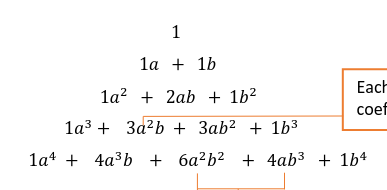(y1 only) sequences and series whole topic
1/21
There's no tags or description
Looks like no tags are added yet.
Name | Mastery | Learn | Test | Matching | Spaced |
|---|
No study sessions yet.
22 Terms
sequence
a list of items e.x. 1, 2, 3 ...
series
the sum of a list of terms e.x. 1 + 2 + 3...
sequence and series definitions
increasing and decreasing- each term is greater/lesser than the previous
periodic- the terms repeat in a cycle (u^(n + k) = u^n with an order of k (k unique terms that repeat))
arithmetic sequences
sequences with a common difference between each term
e.x. a, a + d, a + 2d
the nth term is given by u^n = a + (n - 1)d
arithmetic series
sum of the terms of an arithmetic sequence
given by s^n = (n/2)(2a + (n - 1)d) or s^n = (n/2)(a + l)
where n is the number of terms, a is the first term, d is the common difference and l is the last term
proving arithmetic serieses
S^n = a + (a + d) + (a + 2d) ... (a + (n - 2)d) + (a + (n - 1)d)
S^n = (a + (n - 1)d) + (a + (n - 2)d) ... (a + 2d) + (a + d) + a
2S^n = n(2a + (n - 1)d)
therefore S^n = (n/2)(2a + (n - 1)d)
geometric sequences
sequences where each term is r times the last
a, ar, ar^2, ar^3 ...
r is the common ratio
geometric sequence equation
the nth term is given by u^n = ar^(n - 1)
also, u^(k + 1)/u^k = u^(k + 2)/u^(k + 1) = r (pick any two pairs of adjacent terms, and the bigger divided by the smaller is the same for each)
geometric series
the sum of the terms of a geometric sequence
s^n = a(1 - r^n)/(1 - r)
also, by multiplying each side by -1:
s^n = a(r^n - 1)/(r - 1)
(invalid when r = 1 as division by zero)
proving geometric series equation
S^n = a + ar ... ar^(n - 1)
rS^n = ar + ar^2 ... ar^n
S^n - rS^n = a - ar^n
S^n(1 - r) = a(1 - r^n)
therefore S^n = a(1 - r^n)/(1 - r)
convergent and divergent sequences
sequences where the terms tend to a fixed limit or to infinity
convergent and divergent series
series where the sum tends to a fixed limit or to infinity
sum to infinity
the sum of converging geometric sequences as n approaches infinity
S^inf = a/(1 - r)
(divergent sequences give infinity)
recurrence relations
a way of defining a sequence where each term is given as a function of the previous
e.x. u^(n + 1) = 2u^(n) + 4
sigma notation
∑- denotes the sum of a series
the number below denotes the first value of r and the number above denotes the last, and the equation to the right denotes the equation applied to r
binomial expansion
the process of expanding (a+b)^n expressions
pascal’s triangle
used to help binomial expansion- the (n+1)th row gives the coefficients in the expansion of (a+b)^n
formed by adding adjacent pairs of numbers to find the numbers on the next row

factorial notation
n! used to help binomial expansion, quicker than Pascal's Triangle for larger indices
nCr
nCr = n!/r!(n-r)!
gives the coefficient for the rth term for (kx+c)^n
the rth entry in the nth row of pascal's triangle is given by (n-1)C(r-1)
binomial expansion
a rule allowing for the quick expansion of brackets e.x.
(a+b)^n = a^n + (nC1)a^(n-1)b + (nC2)a(n-2)b^2 ...
finding coefficiencts
the coefficient of x^n in the binomial expansion (kx + c)^m is:
(mCn)(k^n)(c^(m-n))
binomial estimation
when x is less than 1, larger powers can be ignored to produce an estimation of the value of a binomial expression as their value will be negligible. the amount of terms to include in the estimation will be provided